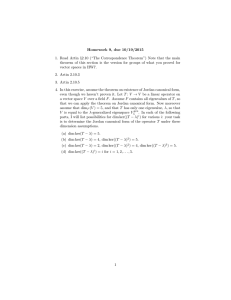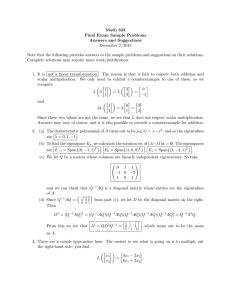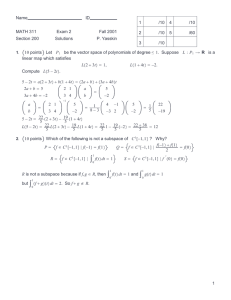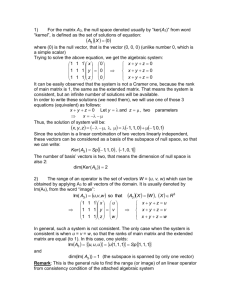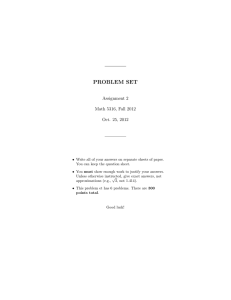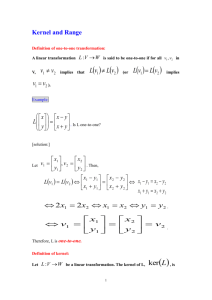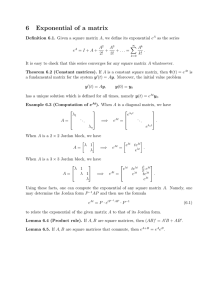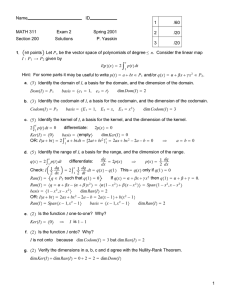Solutions to second midterm
advertisement
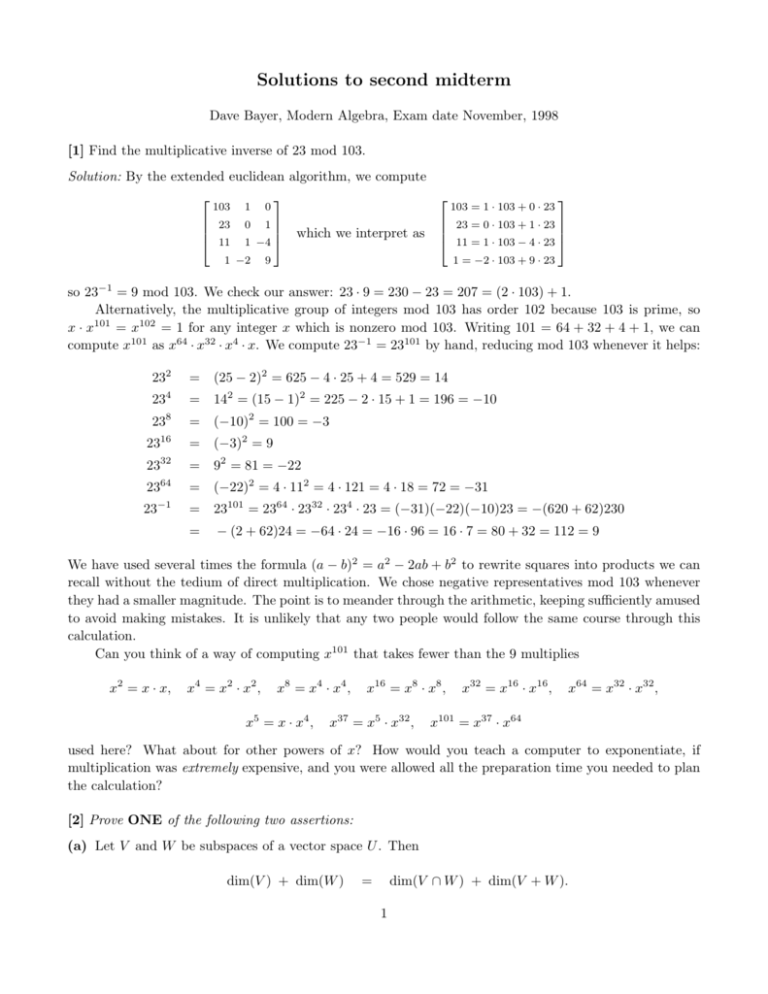
Solutions to second midterm Dave Bayer, Modern Algebra, Exam date November, 1998 [1] Find the multiplicative inverse of 23 mod 103. Solution: By the extended euclidean algorithm, we compute 103 1 23 11 0 0 which we interpret as 23 = 0 · 103 + 1 · 23 1 −4 11 = 1 · 103 − 4 · 23 1 −2 1 103 = 1 · 103 + 0 · 23 1 = −2 · 103 + 9 · 23 9 so 23−1 = 9 mod 103. We check our answer: 23 · 9 = 230 − 23 = 207 = (2 · 103) + 1. Alternatively, the multiplicative group of integers mod 103 has order 102 because 103 is prime, so 101 x·x = x102 = 1 for any integer x which is nonzero mod 103. Writing 101 = 64 + 32 + 4 + 1, we can compute x101 as x64 · x32 · x4 · x. We compute 23−1 = 23101 by hand, reducing mod 103 whenever it helps: 232 = (25 − 2)2 = 625 − 4 · 25 + 4 = 529 = 14 234 = 142 = (15 − 1)2 = 225 − 2 · 15 + 1 = 196 = −10 238 = (−10)2 = 100 = −3 2316 = (−3)2 = 9 2332 = 92 = 81 = −22 2364 = (−22)2 = 4 · 112 = 4 · 121 = 4 · 18 = 72 = −31 23−1 = 23101 = 2364 · 2332 · 234 · 23 = (−31)(−22)(−10)23 = −(620 + 62)230 = − (2 + 62)24 = −64 · 24 = −16 · 96 = 16 · 7 = 80 + 32 = 112 = 9 We have used several times the formula (a − b)2 = a2 − 2ab + b2 to rewrite squares into products we can recall without the tedium of direct multiplication. We chose negative representatives mod 103 whenever they had a smaller magnitude. The point is to meander through the arithmetic, keeping sufficiently amused to avoid making mistakes. It is unlikely that any two people would follow the same course through this calculation. Can you think of a way of computing x101 that takes fewer than the 9 multiplies x2 = x · x, x4 = x2 · x2 , x8 = x4 · x4 , x5 = x · x4 , x16 = x8 · x8 , x37 = x5 · x32 , x32 = x16 · x16 , x64 = x32 · x32 , x101 = x37 · x64 used here? What about for other powers of x? How would you teach a computer to exponentiate, if multiplication was extremely expensive, and you were allowed all the preparation time you needed to plan the calculation? [2] Prove ONE of the following two assertions: (a) Let V and W be subspaces of a vector space U . Then dim(V ) + dim(W ) dim(V ∩ W ) + dim(V + W ). = 1 Solution: Choose a basis u1 , . . . , uj for V ∩W . Extend u1 , . . . , uj to a basis u1 , . . . , uj , v1 , . . . , vk for V . Also extend u1 , . . . , uj to a basis u1 , . . . , uj , w1 , . . . , w for W . We claim that u1 , . . . , uj , v1 , . . . , vk , w1 , . . . , w is a basis for V + W . Counting basis elements, the formula will follow as (j + k) + (j + ) = (j) + (j + k + ). Independence: For any expression j ri u i + i=1 k si vi + i=1 ti wi = 0 i=1 we need to show that all coefficients ri , si , ti are zero. Write α = j ri u i + k i=1 si vi − = i=1 ti wi . i=1 We see that α ∈ V and α ∈ W , so α ∈ V ∩ W . Since u1 , . . . , uj is a basis for V ∩ W , α can be written in a unique way as a linear combination of u1 , . . . , uj . This same expression must be the unique way of writing α as a linear combination of the basis u1 , . . . , uj , w1 , . . . , w for W , so we have t1 = . . . = t = 0. Thus α = 0. Because u1 , . . . , uj , v1 , . . . , vk is a basis for V , we have r1 = . . . = rj = 0 and s1 = . . . = sk = 0 as desired. Spanning: If u ∈ V + W , we need to show that u can be written as a linear combination of the vectors u1 , . . . , uj , v1 , . . . , vk , w1 , . . . , w . Write u = v + w where v ∈ V and w ∈ W , and write v = j ri u i + i=1 k = and w = i=1 Then u si vi j v+w = ri ui + i=1 j (ri + ri ) ui + i=1 k ti wi . i=1 si vi + i=1 ti wi i=1 as desired. (b) Let T : V → W be a linear transformation of vector spaces. Then dim(ker(T )) + dim(image(T )) = dim(V ). Solution: There are various ways to prove this; here is one: Choose a basis u1 , . . . , uj for ker(T ), and choose a basis w1 , . . . , wk for image(T ). For each wi ∈ W , choose a vector vi ∈ V so T (vi ) = wi . We claim that u1 , . . . , uj , v1 , . . . , vk is a basis for V . Counting basis elements, the formula will follow as (j) + (k) = (j + k). Independence: For any expression j i=1 ri u i + k i=1 2 si vi = 0 we need to show that all coefficients ri , si are zero. Applying T , we have T j ri u i + i=1 k = si vi k 0 + i=1 si T (vi ) k = i=1 si wi = 0, i=1 so si = . . . = sk = 0 because w1 , . . . , wk is a basis for image(T ). Now ri = . . . = rj = 0 because u1 , . . . , uj is a basis for ker(T ). Spanning: If v ∈ V , we need to show that v can be written as a linear combination of the vectors k k k u1 , . . . , uj , v1 , . . . , vk . Write T (v) = i=1 si wi . Then T (v) = T ( i=1 si vi ), so v − i=1 si vi belongs to ker(T ). Write v− k si vi = i=1 j ri u i , so v= i=1 j ri u i + i=1 [3] Let A= si vi as desired. i=1 . 5 −4 1 k 1 Find a change of basis matrix B so A = B C B −1 where C is in Jordan canonical form. Use B and C to give an expression for eAt . You do not need to multiply this expression out. Solution: A has characteristic polynomial λ2 − trace(A)λ + det(A) λ2 − 6λ + 9 = (λ − 3)2 , = so A has a repeated eigenvalue of 3. We have A − 3I = 2 −4 1 −2 which is a nonzero matrix, so we have the Jordan canonical forms 0 1 3 1 for A − 3I, and for A, 0 0 0 3 with respect to any basis v1 , v2 such that (A − 3I) v2 = v1 (A − 3I) v1 and = 0. This will hold for most choices of v2 , so we try v2 = (1, 0). We have (A − 3I)(1, 0) = (2, 1), and (A − 3I)(2, 1) = (0, 0) as desired. Thus A = We check our work: 2 1 0 1 1 0 1 −2 = 1 0 0 1 , 5 −4 1 1 and = 2 1 1 0 2 1 1 0 3 1 0 3 3 3 1 1 1 −2 1 1 −2 0 3 0 0 = . 2 1 1 0 1 1 3 −6 = 5 −4 1 1 . It follows that At e = 5 −4 1 1 = 2 1 e3t te3t 1 1 −2 0 e3t 1 0 0 . [4] Let T : V → V be a linear transformation from the n-dimensional vector space V to itself, such that T 2 = 0. Prove that for some basis v1 , . . . , vn of V , the matrix A for T with respect to this basis is in Jordan canonical form. Solution: We have image(T ) ⊂ ker(T ), because w ∈ image(T ) ⇒ w = T (v) ⇒ T (w) = T 2 (v) = 0. Choose a basis w1 , . . . , wj for image(T ), and extend this basis to a basis w1 , . . . , wj , u1 , . . . , uk for ker(T ). For each wi , choose a vector vi ∈ V so T (vi ) = wi . We claim that w1 , . . . , wj , u1 , . . . , uk , v1 , . . . , vj is a basis for V . Arranging this basis in the order v1 , w1 , . . . , vj , wj , u1 , . . . , uk and relabeling as v1 , . . . , vn gives the desired Jordan form. Independence: For any expression j ri wi + i=1 k si ui + i=1 j ti vi = 0 i=1 we need to show that all coefficients ri , si , ti are zero. Applying T , we have T j ri wi + i=1 k si ui + i=1 j ti vi = 0 + 0 + i=1 j ti T (vi ) j = i=1 yi wi = 0, i=1 so ti = . . . = tj = 0 because w1 , . . . , wk is a basis for image(T ). Now ri = . . . = rj = 0 and si = . . . = sk = 0 because w1 , . . . , wj , u1 , . . . , uk is a basis for ker(T ). Spanning: If v ∈ V , we need to show that v can be written as a linear combination of the vectors j j j u1 , . . . , uj , v1 , . . . , vk . Write T (v) = i=1 ti wi . Then T (v) = T ( i=1 ti vi ), so v − i=1 ti vi belongs to ker(T ). Write j j k ti vi = ri wi + si ui , v− i=1 so v = j i=1 i=1 k ri wi + i=1 si ui + i=1 j ti vi i=1 as desired. [5] Let λ 1 0 A = 0 λ 1 . 0 0 λ Find a formula for eAt . Solution: We first need a formula for An . We have 2 3 λ 1 0 λ 2λ 1 0 λ λ 3λ2 3λ 0 λ λ4 4λ3 6λ2 λ5 5λ4 10λ3 A1 = 0 λ 1 , A2 = 0 λ2 2λ , A3 = 0 λ3 3λ2 , A4 = 0 λ4 4λ3 , A5 = 0 λ5 5λ4 0 0 λ 0 0 4 0 0 λ 0 0 λ allowing us to guess that λn n(n−1) n−2 λ 2 nλn−1 0 λn λn nλn−1 An = 0 0 We check this formula inductively: λ 1 0 λn n(n−1) n−2 λ 2 nλn−1 0 λn λn nλn−1 An+1 = A An = 0 λ 1 0 0 0 λ 0 = λ(n+1) (n+1)n n−1 λ 2 (n + 1)λn 0 λ(n+1) λ(n+1) (n + 1)λn 0 0 as desired. Now, eAt = ∞ An n=0 tn n! = λn nλn−1 0 n(n−1) n−2 λ 2 λn nλn−1 0 0 λn n=0 = ∞ ∞ ∞ λn tn n=0 n! nλn−1 tn n! n=0 ∞ λn tn n=0 n! 0 ∞ λ n tn n! n=0 ∞ nλn−1 tn n! n=0 ∞ n=0 n(n−1) n−2 n λ t 2 n! tn n! n(n−1) n−2 n λ t 2 n=0 0 Now, ∞ ∞ n! nλn−1 tn n! n=0 ∞ λn tn n=0 n! 0 = eλt ∞ λn−1 tn−1 = t (n − 1)! n=1 = = ∞ t2 λn−2 tn−2 2 n=2 (n − 2)! so eAt = ∞ λ n tn t n! n=0 ∞ t2 λ n t n 2 n=0 n! = t2 λt e 2 λt e teλt eλt teλt 0 0 giving us the desired formula. 5 0 eλt = t eλt = t2 λt e 2
